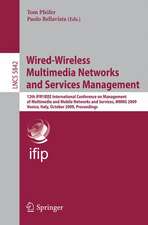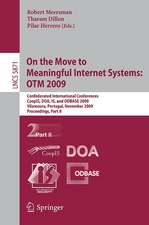Connected Vehicles in the Internet of Things: Concepts, Technologies and Frameworks for the IoV
Editat de Zaigham Mahmooden Limba Engleză Hardback – 14 ian 2020
A connected vehicle is a vehicle equipped with Internet access and wireless LAN, which allows the sharing of data through various devices, inside as well as outside the vehicle. The ad-hoc network of such vehicles, often referred to as VANET or the Internet of vehicles (IoV), is an application of IoT technology, and may be regarded as an integration of three types of networks: inter-vehicle, intra-vehicle, and vehicular mobile networks. VANET involves several varieties of vehicle connectivity mechanisms, including vehicle-to-infrastructure (V2I), vehicle-to-vehicle (V2V), vehicle-to-cloud (V2C), and vehicle-to-everything (V2X). According to one survey, it is expected that there will be approximately 380 million connected cars on the roads by 2020. IoV is an important aspect of the new vision for smart transportation.
The book is divided into three parts: examining the evolution of IoV (basic concepts, principles, technologies, and architectures), connectivity of vehicles in the IoT (protocols, frameworks, and methodologies), connected vehicle environments and advanced topics in VANETs (security and safety issues, autonomous operations, machine learning, sensor technology, and AI).
By providing scientific contributions and workable suggestions from researchers and practitioners in the areas of IoT, IoV, and security, this valuable reference aims to extend the body of existing knowledge.
| Toate formatele și edițiile | Preț | Express |
|---|---|---|
| Paperback (1) | 990.12 lei 6-8 săpt. | |
| Springer International Publishing – 15 ian 2021 | 990.12 lei 6-8 săpt. | |
| Hardback (1) | 996.56 lei 6-8 săpt. | |
| Springer International Publishing – 14 ian 2020 | 996.56 lei 6-8 săpt. |
Preț: 996.56 lei
Preț vechi: 1245.69 lei
-20% Nou
Puncte Express: 1495
Preț estimativ în valută:
190.72€ • 198.37$ • 157.45£
190.72€ • 198.37$ • 157.45£
Carte tipărită la comandă
Livrare economică 15-29 aprilie
Preluare comenzi: 021 569.72.76
Specificații
ISBN-13: 9783030361662
ISBN-10: 3030361667
Ilustrații: XXVIII, 331 p. 97 illus., 84 illus. in color.
Dimensiuni: 155 x 235 mm
Greutate: 0.68 kg
Ediția:1st ed. 2020
Editura: Springer International Publishing
Colecția Springer
Locul publicării:Cham, Switzerland
ISBN-10: 3030361667
Ilustrații: XXVIII, 331 p. 97 illus., 84 illus. in color.
Dimensiuni: 155 x 235 mm
Greutate: 0.68 kg
Ediția:1st ed. 2020
Editura: Springer International Publishing
Colecția Springer
Locul publicării:Cham, Switzerland
Cuprins
1. Connected Vehicles in the IoV: Concepts, Technologies and Architectures.- 2. Spatial Intelligence and Vehicle-to-Vehicle Communication: Topologies and Architectures.- 3. Seamless V2I Communication in HetNet: State-of-the-Art and Future Research Directions.- 4. Integrating Vehicular Technologies within the IoT Environment: A Case of Egypt.- 5. Protocols and Design Structures for Vehicular Networks.- 6. Intelligent Traffic Management Systems for Next Generation IoV in Smart City Scenario.
Notă biografică
Professor Zaigham Mahmood is a Technology Consultant at Debesis Education, UK, and a Professor at the Shijiazhuang Tiedao University in Hebei, China. He also holds positions as Foreign Professor at NUST and IIU in Islamabad, Pakistan. He previously served as a Reader (Associate Professor) at the University of Derby, UK, and Professor Extraordinaire at the North-West University, Potchefstroom, South Africa. His many publications include the Springer titles Software Engineering in the Era of Cloud Computing; The Internet of Things in the Industrial Sector; Security, Privacy and Trust in the IoT Environment; Guide to Ambient Intelligence in the IoT Environment; Fog Computing; Smart Cities; Connected Environments for the Internet of Things; Software Project Management for Distributed Computing; Requirements Engineering for Service and Cloud Computing; Connectivity Frameworks for Smart Devices; Data Science and Big Data Computing; Cloud Computing: Challenges, Limitationsand R&D Solutions; Continued Rise of the Cloud; Cloud Computing: Methods and Practical Approaches; Software Engineering Frameworks for the Cloud Computing Paradigm; and Cloud Computing for Enterprise Architectures.
Textul de pe ultima copertă
This book presents an overview of the latest smart transportation systems, IoV connectivity frameworks, issues of security and safety in VANETs, future developments in the IoV, technical solutions to address key challenges, and other related topics.
A connected vehicle is a vehicle equipped with Internet access and wireless LAN, which allows the sharing of data through various devices, inside as well as outside the vehicle. The ad-hoc network of such vehicles, often referred to as VANET or the Internet of vehicles (IoV), is an application of IoT technology, and may be regarded as an integration of three types of networks: inter-vehicle, intra-vehicle, and vehicular mobile networks. VANET involves several varieties of vehicle connectivity mechanisms, including vehicle-to-infrastructure (V2I), vehicle-to-vehicle (V2V), vehicle-to-cloud (V2C), and vehicle-to-everything (V2X). According to one survey, it is expected that there will be approximately 380 million connected carson the roads by 2020. IoV is an important aspect of the new vision for smart transportation.
The book is divided into three parts: examining the evolution of IoV (basic concepts, principles, technologies, and architectures), connectivity of vehicles in the IoT (protocols, frameworks, and methodologies), connected vehicle environments and advanced topics in VANETs (security and safety issues, autonomous operations, machine learning, sensor technology, and AI).
By providing scientific contributions and workable suggestions from researchers and practitioners in the areas of IoT, IoV, and security, this valuable reference aims to extend the body of existing knowledge.
A connected vehicle is a vehicle equipped with Internet access and wireless LAN, which allows the sharing of data through various devices, inside as well as outside the vehicle. The ad-hoc network of such vehicles, often referred to as VANET or the Internet of vehicles (IoV), is an application of IoT technology, and may be regarded as an integration of three types of networks: inter-vehicle, intra-vehicle, and vehicular mobile networks. VANET involves several varieties of vehicle connectivity mechanisms, including vehicle-to-infrastructure (V2I), vehicle-to-vehicle (V2V), vehicle-to-cloud (V2C), and vehicle-to-everything (V2X). According to one survey, it is expected that there will be approximately 380 million connected carson the roads by 2020. IoV is an important aspect of the new vision for smart transportation.
The book is divided into three parts: examining the evolution of IoV (basic concepts, principles, technologies, and architectures), connectivity of vehicles in the IoT (protocols, frameworks, and methodologies), connected vehicle environments and advanced topics in VANETs (security and safety issues, autonomous operations, machine learning, sensor technology, and AI).
By providing scientific contributions and workable suggestions from researchers and practitioners in the areas of IoT, IoV, and security, this valuable reference aims to extend the body of existing knowledge.
Caracteristici
Discusses the latest research on wireless connectivity, machine learning, sensor technology, and autonomous operations in the IoV vision Presents technical solutions that address the key challenges and limitations of VANETs Serves as a comprehensive reference resource on IoV and VANETs for students, researchers, and practitioners



























